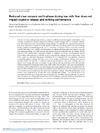Identificador persistente para citar o vincular este elemento:
https://accedacris.ulpgc.es/jspui/handle/10553/77929
| Título: | Reduced claw vacuum and b-phase during low milk flow does not impact oxytocin release and milking performance | Autores/as: | Neuheuser, Anna-Lena Schwinn, Ann-Catherine Wellnitz, Olga Hernández Castellano, Lorenzo Enrique Bruckmaier, Rupert M. |
Clasificación UNESCO: | 3104 Producción Animal | Palabras clave: | Milking Oxytocin Vacuum Pulsation Dairy cows |
Fecha de publicación: | 2017 | Publicación seriada: | Journal of Dairy Research | Resumen: | Oxytocin release, milking characteristics, and teat condition were investigated with reduced claw vacuum and pulsation settings compared to milking at regular settings with or without pre-stimulation. The reduced vacuum and pulsation settings during low milk flow are expected to protect the teat tissue before the occurrence of milk ejection at the start of milking, and at the end of milking during a potential overmilking period, i.e. at a milk flow <200 g/min. Seven cows were machine-milked either after a 60 s manual pre-stimulation, or without pre-stimulation and reduced vacuum and pulsation settings, or at full vacuum and normal pulsation during the start of milking. Plasma oxytocin (OT) concentration increased similarly in response to manual pre-stimulation and to both milking with reduced, or with full vacuum and pulsation settings, however delayed by 1 min if the cluster was attached without pre-stimulation. In all treatments OT concentrations remained elevated throughout milking. Milk flow curves were mostly non-bimodal at milkings after manual pre-stimulation and bimodal at milkings without pre-stimulation. The main milking time was shorter and average milk flow was higher during milking after pre-stimulation, but did not differ between treatments without pre-stimulation. Milk yields and peak flow rates were not affected by treatments. Either reduced or full vacuum settings were again applied during an intended overmilking from 200 to 100 g/min of milk flow towards the end of milk harvest. Pre-milking teat ultrasound cross sections were recorded one day before the experiment started. Post-milking ultrasound cross sections were performed at 15 min after each experimental milking. Teat wall thickness was increased after milking as compared to pre-milking but did not differ among treatments. In conclusion, OT release and milking performance are similar if milking is performed with pre-stimulation, or without pre-stimulation but reduced claw vacuum and b-phase during low milk flow. | URI: | https://accedacris.ulpgc.es/handle/10553/77929 | ISSN: | 0022-0299 | DOI: | 10.1017/S0022029917000504 | Fuente: | Journal of Dairy Research [ISSN 0022-0299], v. 85(1), p. 70 - 77 |
| Colección: | Artículos |
Citas de WEB OF SCIENCETM
Citations
7
actualizado el 08-jun-2025
Visitas
92
actualizado el 13-sep-2024
Descargas
246
actualizado el 13-sep-2024
Google ScholarTM
Verifica
Altmetric
Comparte
Exporta metadatos
Los elementos en ULPGC accedaCRIS están protegidos por derechos de autor con todos los derechos reservados, a menos que se indique lo contrario.
